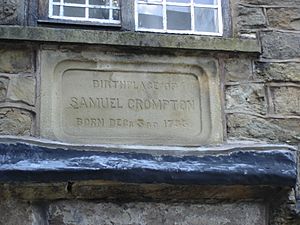10 Firwood Fold facts for kids
Quick facts for kids 10 Firwood Fold |
|
|---|---|

10 Firwood Fold
|
|
| General information | |
| Town or city | Bolton, Greater Manchester |
| Country | England |
| Coordinates | 53°35′44″N 2°24′19″W / 53.595517°N 2.405319°W |
| Completed | 16th century |
10 Firwood Fold is a very old house located in Bolton, Greater Manchester, England. This historic building was built way back in the 1500s. It is a special place because it is the birthplace of Samuel Crompton, a famous inventor, who was born there in 1753.
This house is also known as a Grade I listed building. This means it is considered very important and protected because of its history and unique architecture.
Contents
Discovering 10 Firwood Fold
10 Firwood Fold is more than just an old house; it's a piece of history. It stands as a reminder of life centuries ago. The house shows how people lived and worked in England during the 16th century.
It is a great example of traditional English architecture from that time. Its walls and structure tell stories of the families who lived there.
Who Was Samuel Crompton?
Samuel Crompton was born at 10 Firwood Fold on December 3, 1753. He grew up to become a very important inventor. His most famous invention was the "spinning mule."
The spinning mule was a machine that made spinning cotton much faster and easier. Before this, people spun cotton by hand or with simpler machines. Crompton's invention helped start the Industrial Revolution. It changed how clothes were made all over the world.
His invention made it possible to produce strong, fine yarn quickly. This helped factories grow and made textiles (cloth) much cheaper.
Life at Firwood Fold
The Crompton family lived in 10 Firwood Fold for several years. They stayed there until 1758. During their time in the house, they earned their living through two main activities: farming and weaving.
Farming meant growing crops and raising animals. Weaving involved making cloth from threads. This was a common way for families to support themselves back then. Many homes were also small workshops.
After 1758, the Crompton family moved to a rented home. This new place was called Hall i' th' Wood, which was also nearby.
What is a Listed Building?
A "listed building" is a building that has been officially recognized as historically or architecturally important. In England, buildings are given different grades of listing.
- Grade I is the highest grade. It means the building is of "exceptional interest." Only about 2.5% of all listed buildings are Grade I.
- Grade II* means it is a "particularly important building of more than special interest."
- Grade II means it is of "special interest."
Being a listed building helps protect it from being changed or demolished. This ensures that important historical structures like 10 Firwood Fold are preserved for future generations to learn from and enjoy.


